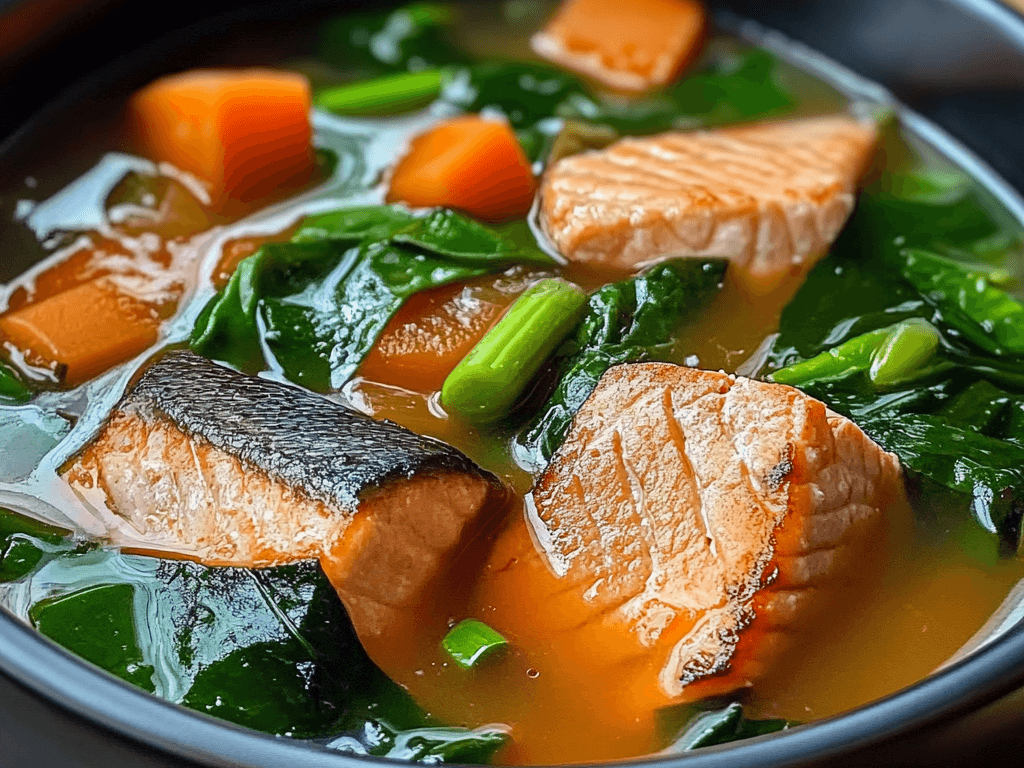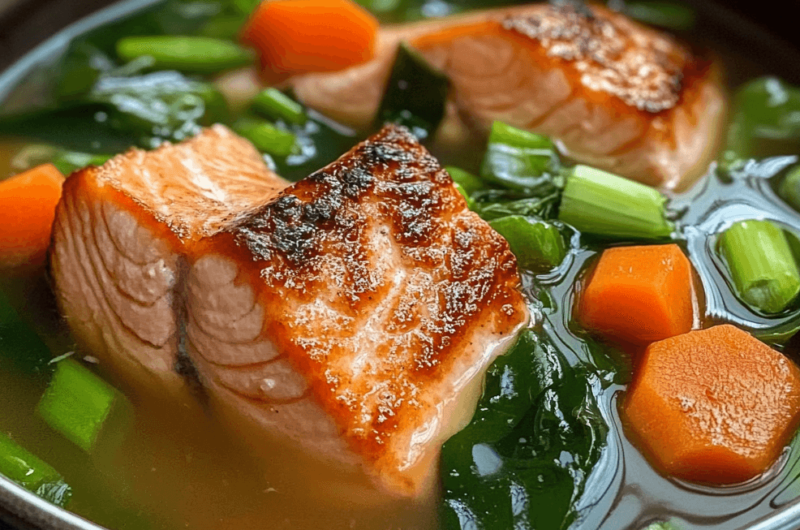Looking for a fresh and flavorful twist on the classic Filipino Sinigang? This Miso Salmon Sinigang is the perfect fusion of rich miso broth and tender salmon fillets, bringing together the comforting tanginess of sinigang with the umami of miso. Packed with vegetables and loaded with nutrients, this dish is not only delicious but also light and satisfying.
The blend of flavors—savory, sour, and a hint of miso’s earthy depth—makes this dish a standout at the dinner table. Whether you’re craving something hearty yet healthy or you want to spice up your usual sinigang routine, this recipe is sure to become a new favorite.
Why You’ll Love This Recipe
Unique & Flavorful: A delightful twist on the traditional sinigang with the addition of miso.
Quick & Easy: Ready in less than an hour, perfect for busy weeknights.
Healthy & Nutritious: Packed with vegetables and omega-3-rich salmon for a wholesome meal.
One-Pot Dish: Minimal cleanup with all the goodness cooked in one pot.
Perfect for All Seasons: Light yet comforting, perfect for both warm and cold weather.
Ingredients
For the Soup Base:
- 1 tablespoon olive oil
- 1 medium onion, sliced
- 2 cloves garlic, minced
- 1-inch piece fresh ginger, sliced
- 1 tablespoon white miso paste
- 6 cups water or low-sodium vegetable broth
- 1 medium tomato, quartered
- 1 medium daikon radish, peeled and sliced
- 1 cup green beans, trimmed and cut into 2-inch pieces
- 1 cup baby bok choy or other leafy greens
- 1-2 tablespoons tamarind paste (or fresh tamarind, if available)
- 1 tablespoon fish sauce
- 1 teaspoon soy sauce (optional)
- Salt and pepper to taste
For the Salmon:
- 4 salmon fillets (about 4-6 ounces each)
- Salt and pepper, to season
- 1 tablespoon olive oil (for cooking the salmon)
Instructions
Prepare the Soup Base
- In a large pot, heat olive oil over medium heat. Add the onion, garlic, and ginger and sauté until fragrant and softened, about 3-4 minutes.
- Stir in the white miso paste and cook for an additional minute, allowing the flavors to meld together.
- Add the water or vegetable broth, tomato, daikon radish, and green beans to the pot. Bring to a gentle boil, then reduce to a simmer.
- Let the soup simmer for about 15-20 minutes, until the vegetables are tender and the broth has developed its flavors.
- Stir in the tamarind paste, fish sauce, and soy sauce (if using), then season with salt and pepper to taste.
- Add the baby bok choy and simmer for another 2-3 minutes until the greens are wilted and tender.
Cook the Salmon
- While the soup is simmering, season the salmon fillets with salt and pepper.
- In a large skillet, heat olive oil over medium-high heat. Add the salmon fillets, skin-side down, and cook for about 4-5 minutes on each side, depending on thickness, until the salmon is cooked through and flakes easily with a fork.
- Remove the salmon from the skillet and set it aside to rest for a few minutes. Once rested, break the salmon into large chunks.
Assemble and Serve
- Carefully add the cooked salmon pieces into the pot of soup, stirring gently to incorporate.
- Simmer for another 2-3 minutes, allowing the flavors to meld together.
- Taste the broth and adjust seasoning if necessary, adding more tamarind or fish sauce to taste.
- Serve hot, garnished with fresh herbs (such as cilantro or green onions) if desired.

Nutritional Information (Per Serving)
Calories: 280 | Protein: 32g | Carbs: 15g | Fat: 13g | Fiber: 5g
(Note: Nutritional values may vary based on ingredient substitutions and serving sizes.)
Tips for Success
- Use Fresh Salmon: Fresh salmon fillets work best, but frozen fillets can also be used. Just ensure they are thawed properly before cooking.
- Adjust the Tanginess: You can increase or decrease the amount of tamarind paste depending on your desired level of sourness in the broth.
- Use Other Vegetables: Feel free to substitute the green beans or daikon radish with other veggies such as carrots, eggplant, or zucchini.
- Make it Spicy: If you like a bit of heat, you can add some sliced chilies to the soup or use chili paste in place of some of the tamarind paste.
- Add More Miso: For a stronger umami flavor, you can add an extra teaspoon of miso paste to the broth.
Why This Recipe Works
- Light & Filling: The combination of salmon, vegetables, and miso creates a meal that’s both satisfying and nutrient-packed.
- Healthy Fats & Protein: Salmon provides healthy omega-3 fatty acids and lean protein, making this dish an excellent choice for a balanced meal.
- Rich Flavor without the Calories: The umami from miso and fish sauce, combined with the tanginess of tamarind, makes the soup full of flavor without added calories.
- Customizable: This recipe can easily be adjusted to suit different tastes, whether you prefer more sourness, spiciness, or different vegetables.
This Miso Salmon Sinigang is a fresh take on a beloved Filipino dish, offering a perfect balance of flavors and textures. The rich miso broth, combined with tender salmon and vibrant vegetables, creates a comforting and hearty meal that’s sure to satisfy your cravings. It’s the perfect dish for any season—light yet flavorful, healthy yet indulgent.
Enjoy this easy, one-pot meal with your loved ones and experience the delicious fusion of flavors that will become a new family favorite!
Miso Salmon Sinigang: A Unique Twist on a Filipino Classic
4
15
minutes20
280
kcalIngredients
For the Soup Base:
1 tablespoon olive oil
1 medium onion, sliced
1 medium onion, sliced
1-inch piece fresh ginger, sliced
1 tablespoon white miso paste
6 cups water or low-sodium vegetable broth
1 medium tomato, quartered
1 medium daikon radish, peeled and sliced
1 cup green beans, trimmed and cut into 2-inch pieces
1 cup baby bok choy or other leafy greens
1-2 tablespoons tamarind paste (or fresh tamarind, if available)
1 tablespoon fish sauce
1 teaspoon soy sauce (optional)
Salt and pepper to taste
For the Salmon:
4 salmon fillets (about 4-6 ounces each)
Salt and pepper, to season
1 tablespoon olive oil (for cooking the salmon)
Instructions
- Prepare the Soup Base
In a large pot, heat olive oil over medium heat. Add the onion, garlic, and ginger and sauté until fragrant and softened, about 3-4 minutes.
Stir in the white miso paste and cook for an additional minute, allowing the flavors to meld together.
Add the water or vegetable broth, tomato, daikon radish, and green beans to the pot. Bring to a gentle boil, then reduce to a simmer.
Let the soup simmer for about 15-20 minutes, until the vegetables are tender and the broth has developed its flavors.
Stir in the tamarind paste, fish sauce, and soy sauce (if using), then season with salt and pepper to taste.
Add the baby bok choy and simmer for another 2-3 minutes until the greens are wilted and tender. - Cook the Salmon
While the soup is simmering, season the salmon fillets with salt and pepper.
In a large skillet, heat olive oil over medium-high heat. Add the salmon fillets, skin-side down, and cook for about 4-5 minutes on each side, depending on thickness, until the salmon is cooked through and flakes easily with a fork.
Remove the salmon from the skillet and set it aside to rest for a few minutes. Once rested, break the salmon into large chunks. - Assemble and Serve
Carefully add the cooked salmon pieces into the pot of soup, stirring gently to incorporate.
Simmer for another 2-3 minutes, allowing the flavors to meld together.
Taste the broth and adjust seasoning if necessary, adding more tamarind or fish sauce to taste.
Serve hot, garnished with fresh herbs (such as cilantro or green onions) if desired.
Notes
- Use Fresh Salmon: Fresh salmon fillets work best, but frozen fillets can also be used. Just ensure they are thawed properly before cooking.
Adjust the Tanginess: You can increase or decrease the amount of tamarind paste depending on your desired level of sourness in the broth.
Use Other Vegetables: Feel free to substitute the green beans or daikon radish with other veggies such as carrots, eggplant, or zucchini.
Make it Spicy: If you like a bit of heat, you can add some sliced chilies to the soup or use chili paste in place of some of the tamarind paste.
Add More Miso: For a stronger umami flavor, you can add an extra teaspoon of miso paste to the broth.


